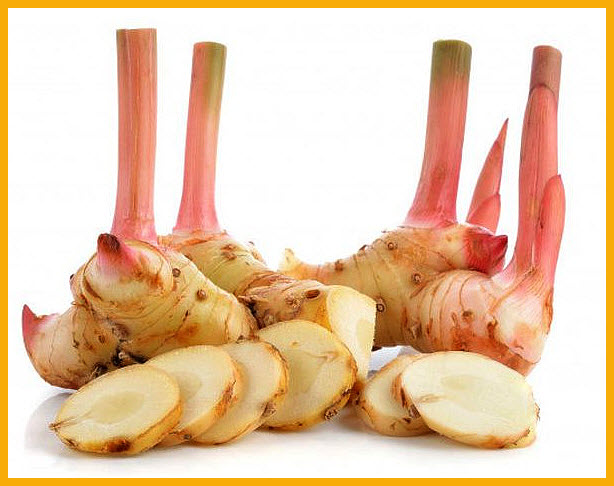What is galangal?
Galangal is an upright herb that is 2 m or more in height. The young stems emerge as shoots from the base of the old stem. The entire stem is covered in leaf midrib. The leaves are single, short-stemmed, elongated lanceolate, pointed tips, blunt bases, and flat edges.
Galangal is a rich source of antioxidants. Antioxidants can help fight disease and protect body cells from free radical damage. The content of vitamin C, alpine, and galangin in galangal can also help you boost your immune system.
Can Galangal be used as a drink?
Galangal actually has a variety of benefits for the body if consumed regularly. Usually, galangal is made in the form of tea and herbal drinks. In a simple way, you can feel the benefits of galangal. The way to make it is quite easy.
What are the health benefits of galangal?
- Against Cancer
Galangal can fight cancer. Various studies have been conducted and are still being developed to reveal the ability of galangal to fight and prevent various types of cancer and tumors.
Galangal is proven to have the ability to prevent stomach cancer, leukemia, melanoma, pancreatic cancer, colon cancer, breast cancer, liver cancer (liver), and cholangiocarcinoma (bile duct cancer). Due to its antioxidant and anti-inflammatory properties, this herb decreases the damage caused by DNA by free radicals and other toxic elements.
- Improve Blood Circulation
This spice has the ability to remove toxins from the body. By doing so, galangal improves blood circulation and allows nutrients to enter the skin tissue.
- Relieves Digestive Problems
Galangal is rich in dietary fiber and phytochemicals that improve digestion. Galangal reduces acid secretion and digestion. A person suffering from ulcers can use galangal to relieve digestive problems. The aroma of this herb also treats nausea.
- Promotes Cardiovascular Health
Galangal is used as a method of preventing heart disease and all the risks associated with the cardiovascular system. Galangal improves heart health. Often used as a medicine for stroke and other heart-related diseases.
- Asthma Control
Galangal has the ability to treat problems related to the respiratory system. Its antispasmodic effect reduces phlegm, as well as dilates bronchioles to reduce asthma levels. Likewise, the herb's anti-inflammatory properties are beneficial in controlling as well as curing conditions like asthma and acute respiratory distress syndrome.
- Reduces Blood Lipids and Cholesterol Flavonoids
Kaempferol, quercetin, and galanin which are present in galangal can reduce cholesterol levels and blood lipid levels. Galangal extract has the ability to fight fatty acid synthase, thereby reducing cholesterol and triglyceride levels.
- Increase Fertility
Galangal has the ability to increase sperm count and male fertility. Research confirms that galangal root can increase sperm count and motility. A 2014 study conducted by the Iranian Journal of Reproductive Medicine on the impact of galangal on male fertility concluded that application of this herb increases sperm count by three times.
Galangal for what medicine?
Galangal is thought to relieve joint pain, for example in cases of osteoarthritis or rheumatoid arthritis. Like ginger and turmeric, galangal contains anti-inflammatory chemical compounds that can help relieve inflammation that causes joint pain.
What are the characteristics of galangal?
The characteristic feature of galangal is that the outer part of the rhizome is slightly reddish brown or pale green yellow. Generally it has white or reddish scales, hard, shiny with a white interior. The old rhizome meat generally has coarse fiber.
How to plant galangal?
Here are the steps for planting galangal:
- Nursery
Galangal seeds are obtained through a seeding process. The seeding begins with drying the freshly harvested galangal, but not until it dries. The rhizomes are then stored for 30-60 days, then broken by hand. Broken galangal should have 3-5 buds, then re-dried for 1-1.5 days. The seeds are dipped in a functional solution to eliminate the fungi and parasites attached. The seeds are then put in a wooden crate and the chili sauce is covered with ash and rice husks in turn until it is full. The seedlings are then opened after 2-4 weeks.
- Planting
Galangal planting is quite easy because the method is almost the same as planting other rhizome plants. Galangal planting is carried out at the beginning of the rainy season. This is because the young shoots need a lot of water. Planting is done on the bed, then making holes for the plants 3-7.5 cm deep. Seedlings are positioned lying in the hole.
- Maintenance
The maintenance of galangal which is carried out includes embroidery, accumulation, weeding, watering. Embroidering is done 2-3 weeks after planting. The fertilizer used is usually manure or compost. Weeding is done when the plants are 2-4 weeks old and is done continuously until the plants are 3-6 weeks old, and stopped when the plants are 6-7 months old. Galangal does not need a lot of water before harvest.
- Fertilization
To meet the nutritional needs of the galangal plant, fertilization is necessary. Fertilization using solid organic fertilizers and liquid organic fertilizers. The functions and dosages of each of the galangal plants are:
1. Solid Organic Fertilizer.
The use of solid organic fertilizers adjusts to the age of the galangal plant. For application to plants, it can be done by dissolving in water and then splashing it or leaking it evenly. For details on the use of solid organic fertilizers, it is carried out before tillage at a dose of 1-2 tablespoons dissolved in 10 liters of water for 50 galangal plants and 14 days after planting, fertilization is carried out again with the same dose.
2. Liquid Organic Fertilizer.
The use of liquid organic fertilizer for galangal is given every 10 days and given by watering or spraying on the plants. For the dosage, 3 bottles of liquid organic fertilizer dissolved in 14 liters of water are splashed on 70 galangal plants.

